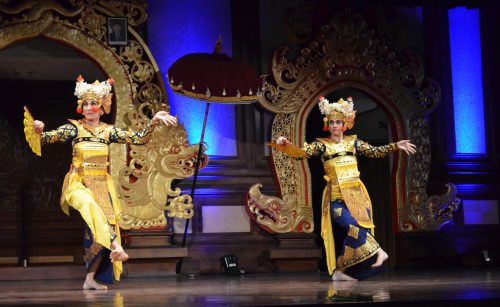
Mysterious forces drew Bonnie Simoa to Bali, Indonesia to study the legong dance, which she has now been practicing for two decades.
Simoa founded a dance company in Davis, California, and as the company was beginning its seventh season, she says she needed something more from her dance life. “I wanted to go some place where dance and spirituality and life were more integrated,” she says. By chance, Simoa came across Bali and then disbanded her company, put her things in storage, left her dog in the care of her sister and relocated to Indonesia for six months.
The legong is considered an abstract dance, Simoa says. Several different versions of the legong exist, and the variations “loosely reference stories.” Simoa specifically teaches the legong keraton playon — the longest and most complex of the legong dances, she says. “[It’s] one of the only legong dances that is a reflection of the pure beauty of nature as opposed to some sort of story,” Simoa explains. “So it’s really about beauty of movement, like the movement of the palm trees or the flora in the wind.”
Every part of the body is incorporated into legong movements, which involve facial expressions, the arms being extended for almost the entirety of the dance, finger movement and complex, quick foot movement. The dancers wear dramatic makeup and the intricate legong costume includes roughly 15 pieces of golden fabric, vibrantly colored sashes and a gold headpiece called a gelungan.
Simoa — lead dance faculty at Lane Community College — will make her 15th trip to the island next spring on sabbatical, where she’ll continue researching the roots of the legong by looking at another Balinese dance — the gambuh. This fall she’s teaching yoga, modern dance, ballet and dance improvisation at LCC.
Gambuh predates the legong, having been performed since the 15th century; whereas, the legong was first documented during the 19th century. “Some of the characters and movement of the legong were taken from the gambuh,” she explains, “and [the gambuh] has also had to have very special attention to preserve it because fewer and fewer people are able to play that music to dance the movements.”
In 2014, Simoa and a group of her students traveled to Indonesia as part of a study abroad program. They performed the legong keraton at the Bali Arts Festival in Denpasar. “It was a very unique event,” she says. “Not only was it foreigners dancing that piece,” but very few dancers — even Balinese dancers — perform the dance now “because it’s so long and so complicated,” according to Simoa.
She describes how every move flows in unison with the music of the gamelan — traditional Balinese music comprised of percussion instruments, sounding similar to the xylophone, are played swiftly with mallets by seated musicians. Simoa’s teacher describes the music and dance “as a husband and wife.”
“Balinese music is fiery, emphatically rhythmic and bright,” Simoa adds.
UNESCO recently named the legong keraton “as part of the world’s intangible cultural heritage,” according to the Jakarta Post. “I think of it like as a dance that’s on the endangered species list,” Simoa says.
Her classes don’t fill up as quickly as they once did — she attributes the decline to the student debt crisis and the cost of education — but she says that anyone in the community can sign up for a dance class at LCC.
Simoa wants her students to leave her dance classes with an appreciation of their bodies and hopes they transpose that mindfulness to their everyday lives so they “feel more alive and maybe more spiritually connected to this world we live in.”
Bonnie Simoa’s Balinese Dance class takes place 2:30-3:50 pm Mondays and Wednesdays during fall quarter at Lane Community College; for further information, visit lanecc.edu.
Help keep truly independent
local news alive!
As the year wraps up, we’re reminded — again — that independent local news doesn’t just magically appear. It exists because this community insists on having a watchdog, a megaphone and occasionally a thorn in someone’s side.
Over the past two years, you helped us regroup and get back to doing what we do best: reporting with heart, backbone, and zero corporate nonsense.
If you want to keep Eugene Weekly free and fearless… this is the moment.